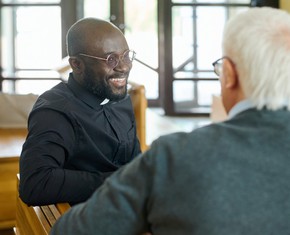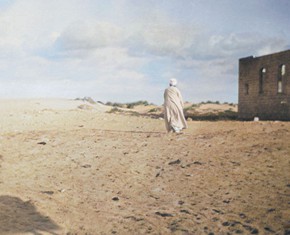The views expressed in our content reflect individual perspectives and do not represent the authoritative views of the Baha'i Faith.
Today, if we hear the word “yoga”, many of us immediately think of the body stretching postures of hatha yoga that bring much-needed health and tranquility to people all over the world. But that’s not the only type of yoga out there.
Yoga was developed in India around five thousand years ago and refers to the achievement of union with the Divine. The process of achieving divine union is often talked of as a journey up a mountain: and there is said to be more than one path up to the spiritual peak. In the Indian tradition, four main types of yoga are commonly recognized: Jnana, Bhakti, Karma and Raja. As we shall see, these four paths to the Divine are also present in the Baha’i Faith.
Before embarking on the journey up the mystic mountain via these four paths, it’s worth pondering the purpose of reaching the peak. What exactly is our ultimate task in life?
Baha’u’llah, the prophet and founder of the Baha’i Faith, wrote the following in a prayer Baha’is recite daily: “I bear witness, O my God, that Thou hast created me to know Thee and to worship Thee.” Here we see two conjoined purposes: to know and to worship God. God is the ultimate reality and therefore the ultimate goal of our existence. If we ignore God, we ignore the truth about life and shut ourselves off from the light that can illuminate our lives.
Here’s how these four yoga approaches help us progress towards God:
Jnana – The path of knowledge
Baha’u’llah has explained that “The beginning of all things is the knowledge of God.” On this path, the spiritual aspirant gains more knowledge of spirituality, and in so doing, abandons false conceptions about life. Through study and contemplation, they draw closer and closer to the origin of all knowledge, God.
To draw closer to God, we need to understand what God is. The Baha’i teachings say that God is the Unknowable Essence beyond all creation, “immensely exalted beyond every human attribute, such as corporeal existence, ascent and descent, egress and regress.”
The Creator’s spirit emanates throughout the universe, and although God is unknowable, we can learn some important things about Him through the prophets, or manifestations of God. Unlike the common person, these divine personages receive revelation directly from God, and teach that God is the all-knowing, all-loving, all-generous being that created us all out of love.
The path of knowledge involves the daily study of the word of God, which enables the seeker to stay focused on their goal and gain more and more insights into reality.
Bhakti – The path of devotion
Because we know about God and believe that He is the ultimate truth and the loving source of all existence, it is only natural that we love Him, too. One of the ways we experience this love is through prayer. As Abdu’l-Baha, the son of Baha’u’llah, said in Star of the West, volume 5, p. 41: “There is nothing sweeter in the world of existence than prayer.”
God’s love is unconditional and ever-flowing. There is nothing we can do that can stop God from loving us. But while God’s love flows constantly down on us, we can block ourselves from this love by acting contrary to God’s standards. In loving God, we turn towards Him and receive that light. In the words of Baha’u’llah: “Love Me, that I may love thee. If thou lovest Me not, My love can in no wise reach thee.”
Not only do we love God—we also love all of humanity. His divine attributes are within us all, so by loving each other, we glorify God and draw ever near to Him.
Karma – The path of service
Because we love God, we naturally want to express our love to Him. If someone loves another person, they will not just want to feel this love or think about it—they will want to express it. In fact, the expression of this love is what proves it to be real.
Throughout his writings, Baha’u’llah stressed the importance of action: “Let deeds, not words, be your adorning.” The highest deed we can perform is service to God, because God is the highest reality: “all effort and exertion put forth by man from the fullness of his heart is worship, if it is prompted by the highest motives and the will to do service to humanity.”
God created all things as an intentional act of love, and that means the world is imbibed with meaning and purpose. Our task in life is to serve God by serving humanity.
Raja – The path of mindfulness
Raja, or the “Royal” path, is the path of mindfulness and meditation. We can also regard Hatha yoga as part of Raja yoga because through performing physical poses, one unifies the body and mind and achieves a state of calm awareness. Ideally, we would maintain a constant sense of mindfulness amid all our daily activities.
But this is no easy feat, which is why we should set aside a regular time for meditation so that we can eliminate all distractions, making it is easier to go within. But what is meditation?

According to the Baha’i Writings, “while you meditate you are speaking with your own spirit. In that state of mind you put certain questions to your spirit and the spirit answers: the light breaks forth and reality is revealed.”
Here we can see that to meditate means to become acquainted with our own souls. The soul is our true self, and yet we hardly know it; we are strangers to ourselves. We go about our busy lives driven by our busy minds, so we cannot see the calm waters beneath the stirred surface. This is why many forms of meditation recommend that we stay still and concentrate the mind so that we can avoid getting caught up in the torrent of thoughts in our minds.
Once these thoughts no longer grip us, we can begin to experience our true inner self, the soul. And what is the human soul? A creation that unlike anything else possesses the capacity to reflect all the attributes of God. The more we perfect these attributes, the more our souls reflect the light of God. In the words of Baha’u’llah: “Thou art My lamp and My light is in thee. Get thou from it thy radiance and seek none other than Me. For I have created thee rich and have bountifully shed My favor upon thee.”
Meditative awareness is essential because if we are oblivious to ourselves, then the other practices will be empty. If we sit down to read sacred texts with our minds elsewhere, we are just holding words on a page. For these texts to be meaningful, we need to be present. If our minds are lost in thought when praying to God, our attention is not fully on Him and so our prayer is less potent. If we are not present for the people we serve, then our acts of service may lack sincerity. This is why mindfulness runs through all our spiritual practices.
At the same time, mindfulness without the three other approaches could become mindless, heartless and fruitless.
These four methods to draw us closer to God aren’t only present in Hindu religious traditions: they also exist in all world religions. Sometimes, one of these spiritual methods is emphasized over the others, but the Baha’i teachings encourage that we use all in combination with each other.
By learning about God, loving Him and serving Him while present to the moment, we can scale the mystic mountain of truth with more vigor.
















Comments
Sign in or create an account
Continue with Googleor